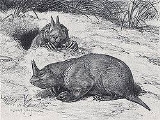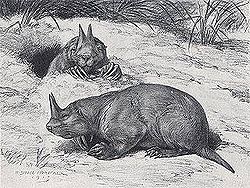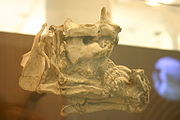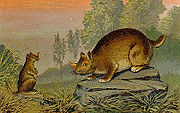
Horned gopher
Encyclopedia
Horned gophers are rodent
s from the genus Ceratogaulus, a member of the extinct fossorial
rodent family Mylagaulidae
. Ceratogaulus is the only known rodent genus with horn
s, and is the smallest known horned mammal. Ceratogaulus lived from the late Miocene to the early Pleistocene era.
 The horned gopher had two horns as shown to the left; these were large (in comparison to body size), paired, and originated from the nose. Horned gophers are the smallest known mammals to ever have horns, and the only known species of horned rodents, and (aside from one fossil
The horned gopher had two horns as shown to the left; these were large (in comparison to body size), paired, and originated from the nose. Horned gophers are the smallest known mammals to ever have horns, and the only known species of horned rodents, and (aside from one fossil
species of armadillo
, Peltephilus
), the only known fossorial
horned mammals. They were native to what is now the Great Plains
of North America
, most concentrated in Nebraska.
The role of the horns is subject to much speculation; possibilities include digging (although this has largely been ruled out by the horns' position and orientation; see below for a more detailed analysis), mating
displays or combat, and defense from predators. Because the horns were not sexually dimorphic
, their role in defense seems most likely.
In most other respects, the animals resembled modern marmot
s. They were approximately 30 centimetre (0.984251968503937 ft) long, and had paddle-like forepaws with powerful claws adapted for digging. They also had small eyes, and probably had poor eyesight, similar to that of a mole
. These features suggest that they were likely to be burrowing animals.
Ceratogaulus horns are positioned on the posterior ends of the nasal bones and extend dorsally, perpendicular to the plane of the palate
. As a result of their posterior position, using the horns to dig would bring the anterior tip of the nasals against the substrate after a very short sweep of the horns, making digging with the horns extremely inefficient. This motion would be even more inefficient than suggested because the anterior surface of a burrow is concave, making it essentially impossible to use the horns without the anterior end of the snout interfering. The expectation is that an animal using its horns anteriorly (rather than dorsally) would have the occipital plate positioned vertically or tilted posteriorly. In this configuration, the effective input lever is maximized when the head is lowered, as in the rhinoceros skull.
 The shape of the horn itself is also very poor for a digging tool. The horns are very thick and broad with large, flat anterior and posterior surfaces. Dragging such a broad tool through the soil would create immense resistance, proportional to the large surface area presented to the substrate. Finally, the Ceratogaulus horn becomes more posteriorly positioned through time, so that the evolutionary trend is towards a horn which becomes more poorly suited to digging through time, rather than better suited. Thus, the argument that the horns functioned in digging is not supported by the morphology or the evolutionary progression.
The shape of the horn itself is also very poor for a digging tool. The horns are very thick and broad with large, flat anterior and posterior surfaces. Dragging such a broad tool through the soil would create immense resistance, proportional to the large surface area presented to the substrate. Finally, the Ceratogaulus horn becomes more posteriorly positioned through time, so that the evolutionary trend is towards a horn which becomes more poorly suited to digging through time, rather than better suited. Thus, the argument that the horns functioned in digging is not supported by the morphology or the evolutionary progression.
 Many of the objections that apply to the horns as a digging implement also apply to the use of the horns in sexual combat. Their orientation and position and the morphology of the rest of the skull make it exceedingly difficult to bring them to bear on an opponent of similar size. The cervical vertebrae are shortened antero-posteriorly in all mylagaulids (a feature inherited
Many of the objections that apply to the horns as a digging implement also apply to the use of the horns in sexual combat. Their orientation and position and the morphology of the rest of the skull make it exceedingly difficult to bring them to bear on an opponent of similar size. The cervical vertebrae are shortened antero-posteriorly in all mylagaulids (a feature inherited
by Ceratogaulus from ancestral, head-digging mylagaulids), decreasing the flexibility and range of motion of the neck and making it even more difficult for Ceratogaulus to wrestle with their horns. Many ungulates with horns ill-suited to sexual combat still use them for combat or for sexual display. However, a sexually selected use of the horns is unlikely in Ceratogaulus, as the optic foramen is very small, roughly 1/2 - 2/3 times the size of that of the mountain beaver
, Aplodonta rufa, which itself has very poor vision. The small size of the optic foramen indicates extremely poor visual acuity, meaning that the females would be unlikely to be able to visually recognize a winner in any sexual displays or sexual combat by the males.
elevating the head dorsally, the horns would be snapped backward, protecting the areas most commonly attacked
by predators. A similar use of postero-dorsal horns has been indicated to decrease predation in horned lizards. As the horns grow taller through evolutionary time, they also become more posteriorly positioned and the height of the occipital plate increases, increasing the leverage for lifting them. By positioning the horns more posteriorly, the output lever is shortened and,
because the muscles used to rotate the skull dorsally attach at the top of the occipital plate, the input lever is
lengthened. Thus, the dorsal strike with the horns would be more powerful as the ratio of output lever to input lever would be increased. This increased leverage would also be helpful in maneuvering the horns to deter predators from attacking at the head or neck, as elevating the head dorsally would snap the horns backward, protecting these vulnerable areas. Predation is by far the dominant cause of mortality in most small mammals, so the benefits provided by a mechanism to reduce predation could offset the substantial evolutionary cost of horns in a fossorial mammal.
Rodent
Rodentia is an order of mammals also known as rodents, characterised by two continuously growing incisors in the upper and lower jaws which must be kept short by gnawing....
s from the genus Ceratogaulus, a member of the extinct fossorial
Fossorial
A fossorial organism is one that is adapted to digging and life underground such as the badger, the naked mole rat, and the mole salamanders Ambystomatidae...
rodent family Mylagaulidae
Mylagaulidae
The Mylagaulidae or mylagaulids are a prehistoric family of sciuromorph rodents. They are known from the Neogene of North America and China...
. Ceratogaulus is the only known rodent genus with horn
Horn (anatomy)
A horn is a pointed projection of the skin on the head of various animals, consisting of a covering of horn surrounding a core of living bone. True horns are found mainly among the ruminant artiodactyls, in the families Antilocapridae and Bovidae...
s, and is the smallest known horned mammal. Ceratogaulus lived from the late Miocene to the early Pleistocene era.
Description

Fossil
Fossils are the preserved remains or traces of animals , plants, and other organisms from the remote past...
species of armadillo
Armadillo
Armadillos are New World placental mammals, known for having a leathery armor shell. Dasypodidae is the only surviving family in the order Cingulata, part of the superorder Xenarthra along with the anteaters and sloths. The word armadillo is Spanish for "little armored one"...
, Peltephilus
Peltephilus
Peltephilus ferox, the Horned Armadillo, was a species of dog-sized, armadillo-like xenarthran mammal which first inhabited Argentina during the Oligocene epoch, and became extinct in the Miocene epoch. Notably, the scutes on its head were so developed that they formed horns protecting its eyes...
), the only known fossorial
Fossorial
A fossorial organism is one that is adapted to digging and life underground such as the badger, the naked mole rat, and the mole salamanders Ambystomatidae...
horned mammals. They were native to what is now the Great Plains
Great Plains
The Great Plains are a broad expanse of flat land, much of it covered in prairie, steppe and grassland, which lies west of the Mississippi River and east of the Rocky Mountains in the United States and Canada. This area covers parts of the U.S...
of North America
North America
North America is a continent wholly within the Northern Hemisphere and almost wholly within the Western Hemisphere. It is also considered a northern subcontinent of the Americas...
, most concentrated in Nebraska.
The role of the horns is subject to much speculation; possibilities include digging (although this has largely been ruled out by the horns' position and orientation; see below for a more detailed analysis), mating
Mating
In biology, mating is the pairing of opposite-sex or hermaphroditic organisms for copulation. In social animals, it also includes the raising of their offspring. Copulation is the union of the sex organs of two sexually reproducing animals for insemination and subsequent internal fertilization...
displays or combat, and defense from predators. Because the horns were not sexually dimorphic
Sexual dimorphism
Sexual dimorphism is a phenotypic difference between males and females of the same species. Examples of such differences include differences in morphology, ornamentation, and behavior.-Examples:-Ornamentation / coloration:...
, their role in defense seems most likely.
In most other respects, the animals resembled modern marmot
Marmot
The marmots are a genus, Marmota, of squirrels. There are 14 species in this genus.Marmots are generally large ground squirrels. Those most often referred to as marmots tend to live in mountainous areas such as the Alps, northern Apennines, Eurasian steppes, Carpathians, Tatras, and Pyrenees in...
s. They were approximately 30 centimetre (0.984251968503937 ft) long, and had paddle-like forepaws with powerful claws adapted for digging. They also had small eyes, and probably had poor eyesight, similar to that of a mole
Mole (animal)
Moles are small cylindrical mammals adapted to a subterranean lifestyle. They have velvety fur; tiny or invisible ears and eyes; and short, powerful limbs with large paws oriented for digging. The term is especially and most properly used for the true moles, those of the Talpidae family in the...
. These features suggest that they were likely to be burrowing animals.
Digging
It has been believed that the horns of the horned gopher were used for digging, but the nasal horns of Ceratogaulus are inconsistent with use as a digging tool. In recent mammals that use the head for excavating, the tip of the snout is used like a spade to scrape at the substrate Therefore, the only modification of the nasal bones is a slight thickening of the anterior tips. Although it is theoretically possible that some mammal might develop horns as a digging tool, digging horns would differ from the Ceratogaulus horns in position and shape.Ceratogaulus horns are positioned on the posterior ends of the nasal bones and extend dorsally, perpendicular to the plane of the palate
Palate
The palate is the roof of the mouth in humans and other mammals. It separates the oral cavity from the nasal cavity. A similar structure is found in crocodilians, but, in most other tetrapods, the oral and nasal cavities are not truly separate. The palate is divided into two parts, the anterior...
. As a result of their posterior position, using the horns to dig would bring the anterior tip of the nasals against the substrate after a very short sweep of the horns, making digging with the horns extremely inefficient. This motion would be even more inefficient than suggested because the anterior surface of a burrow is concave, making it essentially impossible to use the horns without the anterior end of the snout interfering. The expectation is that an animal using its horns anteriorly (rather than dorsally) would have the occipital plate positioned vertically or tilted posteriorly. In this configuration, the effective input lever is maximized when the head is lowered, as in the rhinoceros skull.

Mating displays or combat

by Ceratogaulus from ancestral, head-digging mylagaulids), decreasing the flexibility and range of motion of the neck and making it even more difficult for Ceratogaulus to wrestle with their horns. Many ungulates with horns ill-suited to sexual combat still use them for combat or for sexual display. However, a sexually selected use of the horns is unlikely in Ceratogaulus, as the optic foramen is very small, roughly 1/2 - 2/3 times the size of that of the mountain beaver
Mountain Beaver
The Mountain Beaver is the most primitive extant rodent. Not to be confused with the North American beaver Castor canadensis, or its relative the Eurasian beaver, Castor fiber, it has several common names including Aplodontia, Boomer, Ground Bear, and Giant Mole...
, Aplodonta rufa, which itself has very poor vision. The small size of the optic foramen indicates extremely poor visual acuity, meaning that the females would be unlikely to be able to visually recognize a winner in any sexual displays or sexual combat by the males.
Defense
Horns are used in defense against predators by almost all horned mammals. Animals will use any weapons at their disposal to fight off predators, and the horns of Ceratogaulus are particularly well suited to defense. The horns are broad and robust and their dorsal orientation and relatively posterior position makes them well suited to protecting the vulnerable eyes and neck. Byelevating the head dorsally, the horns would be snapped backward, protecting the areas most commonly attacked
by predators. A similar use of postero-dorsal horns has been indicated to decrease predation in horned lizards. As the horns grow taller through evolutionary time, they also become more posteriorly positioned and the height of the occipital plate increases, increasing the leverage for lifting them. By positioning the horns more posteriorly, the output lever is shortened and,
because the muscles used to rotate the skull dorsally attach at the top of the occipital plate, the input lever is
lengthened. Thus, the dorsal strike with the horns would be more powerful as the ratio of output lever to input lever would be increased. This increased leverage would also be helpful in maneuvering the horns to deter predators from attacking at the head or neck, as elevating the head dorsally would snap the horns backward, protecting these vulnerable areas. Predation is by far the dominant cause of mortality in most small mammals, so the benefits provided by a mechanism to reduce predation could offset the substantial evolutionary cost of horns in a fossorial mammal.

